Whether the handler is into hunting, plinking or target shooting-and the majority of .22 owners probably venture into all three areas-there is a rifle style to suit their fancy. The semi-serious will likely own a bull-barreled version at some time in their lives-a step above the standard model with an implied accuracy advantage that appeals to both hunter and target shooter.
To see how bigger, heavier fancier .22s performed, we shot and
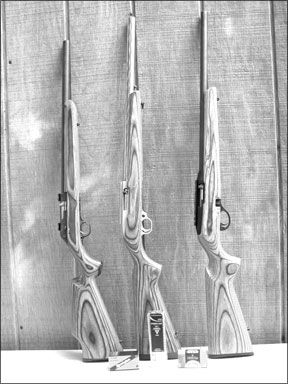
compared three heavy-barreled versions of longstanding .22 LR autoloaders. All featured bull barrels with recessed “target” crowns and blow-back bolt cycling designs, 10-shot detachable magazines, heavy laminate stocks with no checkering, sling swivel studs, and were packed with keyed locking devices.
No such comparison would be complete without a Ruger 10-22, the most popular rimfire autoloader of all time, so we selected the 10-22 K10/2T, $495, to pit against the Remington 597 LS HB 26579, $337, and Thompson Centers R-55 Benchmark Classic No. 6873, $455.
The barrels are the major departures from the base designs in each case. The Ruger 10-22 and Remington 597 feature 20-inch heavy (0.915- and 0.825-inch diameters, respectively) tubes, while the 18-inch Thompson Center barrel measures 0.880 inch. All were button-rifled at the classic .22 LR 1-in-16-inches twist rate.
The heavy tubes featured on the three test guns rather offer stiffness to aid accuracy and consistency; bulk to offset minor fluctuations in trigger pressure; and out-front weight to better steady ones hold.
Barrel length also means very little. In a rimfire configuration, with a peak of 21,000-psi chamber pressure, the same velocities can be derived from a 12-inch barrel as from a 24-incher. Despite the industrys insistence on longer barrels, .22 LR fanatics universally agree that peak accuracy comes from the civilian-minimum 16-inch barrels, which are stiffer and contain the bullet for a shorter period of time than their longer counterparts.
How We Tested
All three guns were tested for function and accuracy at the range on a breathless, humid summer day at 900 feet elevation. There were no malfunctions in terms of feeding, cycling, or misfires with any of the guns.
We fitted each gun with a Kahles 2-7x36mm rimfire scope and shot
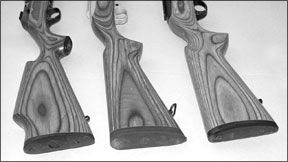
our accuracy groups at 25 and 50 yards using a Caldwell Lead Sled DFT. The resulting groups printed on the Birchwood Casey Shoot-N-C targets were measured center-to-center with an electronic digital caliper.
Our test ammos were Remington/Eley Club Xtra No. RE22CX, Federal Gold Medal Match No. 711B, and CCI Green Tag No. 0033 40-grain loads. Rather than reporting chronograph and energy data for .22s, we expanded our accuracy testing results (see nearby table) to include results at two distances. But the catalog average muzzle velocity/energy readings were as follows: Remington/Eley Club Xtra, 1,085 fps/105 foot-pounds; Federal Gold Medal Match, 1,080 fps/104 foot-pounds; and CCI Green Tag, 1,070 fps/102 foot-pounds.
Heres what we thought about the guns in more detail:
Ruger 10-22 K10/2T, $495
In 1964, Sturm, Ruger & Company introduced the 10-22 as a rimfire version of the chunky 6-pound autoloading .44 Magnum Carbine, which had come out three years earlier.
For a semiautomatic, the 10-22 was innovative and the design has endured as a masterpiece in durable, affordable simplicity. The 5-pound gun features a clever 10-round rotary magazine that flush-fit in the action well of the stock, precisely at the guns balance point.
The package has changed very little, aside from occasional aesthetic facelifts, over the intervening four-plus decades, and it today reigns as the most popular rimfire rifle in history with more than 4 million sold.
Briley, Rhino, Volquartsen, Power Custom, Clark Custom, Magnum Research, Dlask Arms, and several other companies offer highly accurate, customized versions of the 10-22, and the K10/2T was apparently Rugers attempt to keep a share of that market at home.
Most impressive to us, the Ruger K10/2T led in accuracy when shooting the Remington/Eley Club Xtra and CCI Green Tag ammos, posting 0.25- and 0.26-inch groups with those ammos at 25 yards, respectively, and 0.61- and 0.46-inch groups at 50 yards, respectively. This accuracy was at least in part due to the trigger, which broke at an average of 5.25 pounds over 10 tries as measured with a digital Lyman Trigger Gauge. Thats a special light setting that Ruger reserves for all of its “T” models-and warns in the instruction manual not to alter, although minor tinkering can drop it to 3+ pounds, and some aftermarket kits can take it as low as 1.5 pounds.
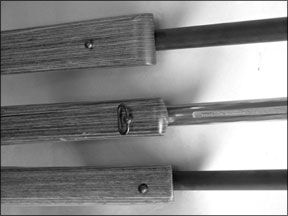
Elsewhere, the K10/2T is fitted with a hammer-forged stainless-steel barrel featuring a unique swirl design on the surface and no iron sights. The normal 10-22 aluminum receiver is painted to approximate a match with the shiny stainless-steel barrel on the K10/2T. The receiver is drilled and tapped to take a Weaver scope rail, and our test gun came with said rail installed. It was also the only gun with an inch-thick rubber recoil pad, apparently for shoulder comfort, since recoil is not a factor in .22 LR.
While the barrels on the Remington 597 and TC Benchmark Classic are free-floated, the Ruger 10-22s aluminum receiver doesnt offer sufficient structural integrity to hang a 3.25-pound barrel from it. The 10-22 barrel is thus attached to the receiver via a V-block with half-inch retaining bolts and is supported for 10-plus inches by the forend.
The K10/2T features a cross-bolt safety located at the front of the trigger guard, and the entire fire control system can be dropped out of the receiver by removing two pins. The gun can be completely disassembled with a blade screwdriver (for the action screw), a 5/32 Allen wrench (to remove the barrel retention screws from the receiver), and a punch to drive out the pins that hold the action and trigger assembly in the aluminum receiver.
Remington 597 LS HB
No. 26579, $337
The 597 is Remingtons latest attempt to grab a share of the market dominated by the Ruger 10-22. To its credit, the 597 is also the longest-lasting, having been introduced in 1997 (“5” being the Remington rimfire model designation and “97” its birthdate).
That 11-year survival of the 597 is a victory of sorts in the head-to-head market with the 10-22. Its arrival as a 10-22 peer is certified by Volquartsens, Boyds, and few other aftermarket companies venture into 597 accessories and upgrades.
This is not to say that the 597 is Remingtons first successful rimfire autoloader. Big Green was at one time the world leader in autoloading rimfires with Models 16, 24, 241, 550, 552 and the Nylon 66 and 77 variants-all full-length rifles-dominating the market from 1915 through the mid-1970s.
The Remington 522 Viper, however, was Remingtons first venture into autoloading rimfire carbines when it was tried and found wanting by the skeptical public from 1993 to 1997. Poor cycling and inconsistent accuracy doomed the 522. The early versions of its successor, the 597, had a few warts of its own that needed to be corrected.
One of the major problems had to do with the guns detachable
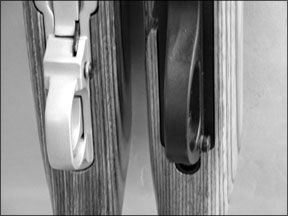
magazine. A staggered vertical design, the initial 10-shot 597 magazines were entirely plastic and virtually useless. Constant failure to feed is a potentially fatal flaw for any firearms design.
A second-generation steel-walled magazine trotted out in the late 1990s was a major improvement. But it took the third, and current, generation to be totally trustworthy. It features a thicker plastic base than the previous two and can be identified by a circled figure “10” on the wall.
The 597 LS/HB (laminated/steel/heavy barrel) features a steel receiver and a unique barrel attachment system that allows the heavy barrel to be free-floated. The twin steel guide system for the bolt is a quality feature.
The Remington was the most ergonomically appealing in our estimation, but its accuracy-while certainly laudable among rimfire autoloaders-paled in comparison to the two more-expensive tack-drivers with which it was juxtapositioned. The 597 liked Remington/Eley Club Xtra best at both distances, shooting 0.61-inch average groups at 25 yards and 0.77-inch average groups at 50 yards. Perhaps some of this accuracy margin was due to the trigger. The trigger on our particular test gun was the heaviest of the three with a 5.6-pound break. However, its only fair to mention that the Teflon-coated trigger components give it the most potential if its properly adjusted.
Magazine extraction was very simple with the Remington (a horizontal slide just above the trigger guard on the right-hand side of the receiver) and the Thompson Center, which featured a generous ambidextrous release lever at the front of the trigger guard. While the Ruger 10-22s flush-fit magazine gives the rifle the cleanest lines of the group, it can be maddening to extract with cold fingers or when wearing gloves. We gave the edge to Remington and T/C in this area.
Also to its credit, the 597 was the only one of the three test guns that featured adjustable iron sights, a factor that some will find useless while others laud its added versatility. And it was the only gun tested that had a grooved receiver for dovetail scope rings as an option to installing a scope rail.
The Remingtons fire-control system can be dropped from the receiver by removing one pin. Safety was a cross-bolt at the rear of the trigger guard.
Thompson Center R-55
Benchmark Classic
No. 6873, $455
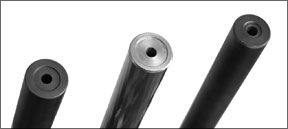
The R-55 rimfire has been a retail home run for Thompson Center since its introduction at the turn of the current century. The Benchmark Classic is the Cadillac version of the R-55 platform with an 18-inch stainless steel bull barrel, with a wide-mouthed target crown, threaded to the steel receiver.
The Benchmark Classic has the looks and features of a target gun, but the sling swivel studs and “all weather” marketing label are apparent gestures to the hunting market.
The Benchmark Classic was the only one of the three test guns that didnt come with a scope rail, although two-piece mounts are available as an accessory (catalog No. 9951). They are identical to the Weaver No. 411.
The light-brown laminated stock was similar in width and heft to the other test guns, but the Benchmark Classics high rollover comb was the most comfortable when all three rifles were scoped. The forend provided a wider (2.25 inches) flat surface for front rest contact than the other guns.
This stock feature likely aided the guns ability to shoot. The TC Benchmark Classic kept Federal Gold Medal Match ammunition inside 0.35 inches at 25 yards and was slightly under a half-inch at 50 yards. The TCs trigger was also a delight and by far the lightest of the test group, averaging 3.6 pounds for 10 pulls on the digital Lyman Trigger Gauge.
These facts alone would likely be enough for us to buy this gun over the others, but we liked other aspects of it as well.
Construction was all steel in the receiver and action parts, with the fire control system held in place by two screws through the trigger guard and two more through the upper receiver walls. Bolts on the Thompson Center and Remington guns handily locked back (open) after the final shot in the magazine, while the Ruger design has never allowed that, forcing the shooter to pull back the bolt to determine if the chamber is clear.
On the warranty, Thompson Center offers a limited lifetime warranty on the R-55 Benchmark Classic, while Remingtons traditional warranty is two years, limited. Ruger doesnt give a written warranty, offering an implied warranty that is determined by the owners state of residence.
There were also a couple of things we didnt like. The safety was a thumb lever along the right side of the receiver-which, unlike the cross-bolt safety, is a virtually incurable headache for the left-handed shooter. The long, curved magazine (10 shots) was by far the most difficult to load among the three tested, the heavy spring making insertion of the last two cartridges a major chore. A different magazine is featured in the instruction manual.
RUGER_10-22_K10-1007_RIMFIRE.pdf
RIMFIRE_REMINGTON_597_LS_HB-1007.pdf

























